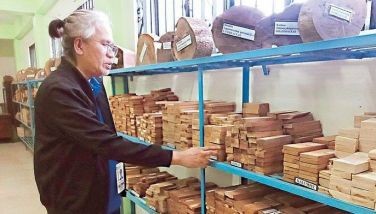Korean investors slam trial by publicity of Hanjin
MANILA, Philippines – South Korean investors have decried the “trial by publicity” of Hanjin Heavy Industries & Construction Ltd. in connection with allegations that the conglomerate violated Philippine environment laws with its construction of a multi-level two-building apartment complex for its Korean personnel in the rainforest of the Subic Freeport.
In a statement, the Korean Chamber of Commerce Philippines Inc. (KCCP) said local media and some politicians raised the accusations against Hanjin “without due process and protection.”
“This incident against Hanjin is dampening the foreign investors’ attitude toward the investment climate in the Philippines,” the statement read.
It said the controversy “betrays the real situation in the Philippine investment climate” where the “sanctity and stability of contracts are not protected.”
“In an incident such as this where a foreign investor complies with all the required government processes and permits and yet is made vulnerable to attacks and accusations of law breaking, who would dare to venture an investment in the Philippines?” KCCP asked.
KCCP said Hanjin has “never violated any Philippine law” and that its $1.65-billion investment in Subic has generated 10,000 local jobs and will create 10,000 more “when operation is in full swing.”
It said Hanjin is building the largest shipbuilding facility in the Philippines and is “seriously considering” a similar but bigger investment in Mindanao.
“This has been cited as a big achievement for the Philippines economically,” KCCP said. “With this issue, the KCCP is alarmed that investors like Hanjin heed the Philippine government’s invitations, but in the end is merely tagged as a brazen violator of public order and is exposed to unwarranted attacks and cloud of suspicion without proper verification,” KCCP said.
KCCP, through its president Jae J. Jang, said the Subic Bay Metropolitan Authority itself said that Hanjin secured the necessary environmental and building permits before it began constructing the two-building complex.
“These permits were applied for observing the procedures and processes required by the respective governmental agencies,” KCCP said. “Everything has been in order and legal.”
KCCP said even media reports admitted that the construction site had long been cleared of trees before Hanjin’s construction work began and that it used to be an ammunition storage facility of the US Navy. “It is highly uncalled for to say that Hanjin has disregarded environmental laws by constructing the two condominium buildings,” it said.
“As such the KCCP condemns the reports which have implied that Hanjin has had no regard for the environment and calls for balanced and objective reporting.”
KCCP said the accusations were ill-timed because the project being questioned is almost finished.
“If the underlying issue has always been environmental protection, then any issues regarding the construction should have been raised at the onset of the building activities, not toward its conclusion,” it said.
“Why is the issue raised only now when the buildings are already 95 percent complete? If the environmental implications of the construction are pressing and urgent why wait over a year before raising it?” KCCP asked. “The protest against it could have been raised from day one.”
It said “concerned parties” should resolve the issue “in the most efficient manner, without creating any more damage” to Hanjin and in “an unbiased and non-partisan approach.”
KCCP said the high-rise condominium, which is almost complete, will house Hanjin’s Korean personnel who “are also tasked to train and educate Filipinos to be world-class shipbuilders.”
Site no lush forest
SBMA deputy administrator Ramon Agregado said Hanjin’s condominium project poses no danger to the environment and is being built over an existing structure.
“It has minimum environmental impact,” Agregado said of the project, which is located at an old US Navy ammunitions depot. Subic was the biggest US naval base outside the continental US until 1992 when the Senate abrogated the RP-US military bases agreement.
“The area has been zoned and developed. The construction is two kilometers away from the core forest area,” Agregado said at a press briefing at Club Filipino in San Juan City. “It is an abandoned bunker previously used by the US Navy,” he said, adding that a building used to stand there but it was underground.
Agregado showed reporters photos of the apartment complex being built on a three-hectare land at the former naval magazine site.
The SBMA official said indigenous people were on hand to help preserve the area.
He said no entertainment establishments like nightclubs or videoke bars will be constructed around the apartment complex.
“Amenities like convenience stores catering to Korean goods and entertainment facilities like nightclubs or karaoke bars are already included in the planned apartments,” he said.
He said that SBMA, in a memorandum of agreement signed with the Department of Environment and Natural Resources in 2006, supervises the issuance of environmental clearance certificates for “critical” non-environmental projects.
He said Hanjin undertook a full-blown environmental impact assessment and secured environmental clearance certificate and zoning clearance from the SBMA. He said the Korean company even secured a height clearance from the Air Transportation Office.
Agregado said Hanjin has been required to plant 700 trees to replace the 28 camachile, guava and jackfruit trees at the project site that it uprooted.
The apartment complex comprises a 22-storey building and a 10-storey building to house 5,000 Hanjin personnel, mostly Koreans. The project is expected to be finished by April next year.
In a press statement, SBMA administrator Armand Arreza said Hanjin has assured authorities that the 13,357-square-meter apartment complex will be managed in conformance with environmental laws. “We cannot, and we won’t put Subic environment at risk, because that’s what makes it unique,” Arreza said.
“Subic’s environment is precisely what makes it tick with investors,” he said.
Meanwhile, a doctor who holds offices at Greenpark Village overlooking the Subic watershed area also belied reports that the Hanjin project encroaches on the watershed and threatens the forest reservation.
Dr. Jose Cesar Cabrera said the project occupies only less than one percent of the forest reservation.
“Besides, Hanjin’s $4-billion investment in Subic contributes greatly to the economy in Olongapo and the whole country,” Cabrera said. – Non Alquitran
- Latest
- Trending




























